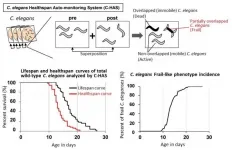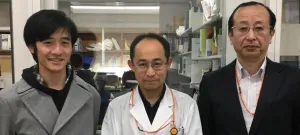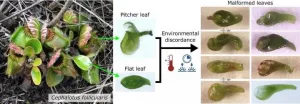(Press-News.org) A research group from Kumamoto University (Japan) has developed an automated measurement system to assess healthy lifespans using nematodes (C. elegans). Based on qualitative differences in lifespans, this system can classify populations of nematodes that are, on average, healthy and long-lived, healthy and die prematurely, and living with long periods of poor health. Since there are many similarities between the mechanisms that determine the lifespan of C. elegans and humans, the researchers believe that this system will make it easier to develop drugs and find foods that extend the healthy lifespan of humans.
The concept of "healthy life expectancy" was proposed in the year 2000 by the World Health Organization (WHO) and is an important indicator for the health of a population. It refers to the average life expectancy minus the period of living dependent on continuous medical or nursing care. However, there is no clear scientific understanding of what constitutes a healthy lifespan in experimental animals or cells. Furthermore, the technology to objectively and rapidly analyze the factors that affect healthy life expectancy has not yet been established.
Despite being an extremely simple animal, C. elegans has differentiated organs such as nerves, skeletal muscles, and a digestive tract, and many mammalian animal-related genes are conserved. It is very useful for cutting-edge research in fields like genetics and molecular biology. However, while lifespan analysis of this nematode provides a great deal of useful information, previous lifespan studies had many limitations including 1) sensitivity to various stimuli at room temperature, 2) a long experimental time required for daily measurements, 3) a lack of objectivity due to a tendency for results to be dependent on experimental technique, and 4) the small number of samples that can be processed at one time making it unsuitable for simultaneous measurement of many samples.
The researchers attempted to resolve these issues by developing a new healthy lifespan assessment system that maintained the advantages provided by nematodes. They focused on determining the optimal conditions in a live cell imaging system for automatically measuring nematode survival, such as counting the number of nematodes in a sample, incubation temperature, medium thickness, feeding conditions, imaging interval, and survival determination method. This became C. elegans Lifespan Auto-monitoring System (C-LAS), a fully automated lifespan measurement system that can non-invasively measure a large number of samples (currently up to 36 samples). C-LAS uses overlapping images of nematodes to identify those that are moving, meaning they are alive, and those that are not moving, meaning they are dead.
Next, by using C-LAS to observe C. elegans, the researchers found that nematodes can be classified as being in one of three possible behavioral states: an active (alive) state, an inactive survival state, or an inactive (dead) state. They defined the period of active behavior as the "healthy lifespan" and established a new system that they called the C. elegans Healthspan Auto-monitoring System (C-HAS). Similar to C-LAS, C-HAS is an automated health and longevity measurement system that can distinguish between live and dead nematodes by overlapping periodic images. It is also possible to detect when nematodes are in an inactive survival state (alive but unhealthy) when they only partially overlap between images. Using C-HAS, researchers can use these parameters for mini-population analyses. This type of analysis makes it possible to divide nematodes with the same genetic background into four groups: those with an average lifespan, those that are healthy and long-lived, those that are unhealthy and die prematurely, and those that have a long period of frailty.
The researchers performed a mini-population analysis of nematode healthy lifespan using a combination of C-HAS and statistical analysis on common nematodes with the same genetic background. They found that about 28% of the population had average lifespans, about 30% had long and healthy lifespans, about 35% had healthy lifespans but died prematurely, and about 7% had a long period of frailty. They also found that activating--either genetically or through administration of the drug metformin--AMP-activated protein kinase (AMPK), which is closely associated with healthy life expectancy, dramatically increased the population with healthy longevity and reduced the population with long periods of frailty. Metformin is thought to increase healthy life expectancy in humans, and the present study supports this idea. Currently, clinical trials are underway to ascertain its association with healthy longevity.
"It might be a little unexpected to see nematodes being used to measure healthy lifespans, but we have already used C-HAS to identify new genes related to healthy lifespan that were previously unknown," said study leader, Associate Professor Tsuyoshi Shuto. "This technology makes it possible to easily search for genes, drugs, or foods that are related to, or even extend, human healthy lifespans with a speed and accuracy that could not be obtained when using laboratory animals. We expect that C-HAS can be used for drug discovery research and in the search for healthy foods in the future. We are currently working on the development of C-HAS-AI, which will incorporate deep learning into C-HAS to boost automated analysis."
INFORMATION:
This research was posted online in the Journal of Pharmacological Sciences on 29 December 2020.
Source:
Nakano, Y., Moriuchi, M., Fukushima, Y., Hayashi, K., Suico, M. A., Kai, H., ... Shuto, T. (2020). Intrapopulation analysis of longitudinal lifespan in Caenorhabditis elegans identifies W09D10.4 as a novel AMPK-associated healthspan shortening factor. Journal of Pharmacological Sciences. doi:10.1016/j.jphs.2020.12.004
A tree grows strong from years of generating its own food. Now imagine if products could be strengthened with the same living materials that provide nutrients to strengthen trees. This is the work of USC Viterbi School of Engineering Civil and Environmental Engineering Professor Qiming Wang whose research lab is one of the first to infuse 3-D printer ink with living material. The material has potential for greater strength, to be flexible and self-heal. The work is documented in a paper published in The Proceedings of the National Academy of Sciences.
The idea for this bio-inspired ink came from trees that harness the power of photosynthesis to produce glucose that transform to ...
In our body, unnecessary cells are removed by regulated cell death. Understanding of the mechanism underlying regulated cell death is critical for the development of therapies for many diseases. Professor Nakano's research group has demonstrated that Mind bomb-2 (MIB2), a ubiquitin ligase, binds to and directly ubiquitinates the cell death suppressor protein cFLIP (Cellular FLICE-inhibitory protein). cFLIP is encoded by CFLAR gene; alternative splicing results in two forms, the long form (cFLIPL) and the short form (cFLIPs). cFLIPL plays a dominant role in suppression ...
January 27, 2021 - For many of us, as we get older the skin on our face begins to sag and we seem to lose volume around our eyes, cheeks and chin. Is gravity taking its toll in our later years or do we lose fat over the course of several years that many of us associate with youth, vibrancy and energy? Understanding the cause is paramount to how plastic surgeons treat the signs of facial aging.
The traditional theory is sagging: the facial soft tissues simply yield to the effects of gravity over time. And while the idea that weakening ligaments in the midface could result in soft tissue descent still has merit, more recent studies point in another direction. Perhaps the real culprit behind facial aging ...
Speaking is something that comes across as an effortless process, almost working by itself. Our brain, however, has a lot of work to do when we construct a sentence. "In addition, languages differ in myriad ways and this also means that there are differences in how we plan what we want to say in different languages," says Balthasar Bickel, senior author of the study and a professor at the University of Zurich.
And if some languages seem easier, it is because they make fewer distinctions in their grammar. While English always uses the (e.g., in "The tree is tall" and "Snow covers the tree"), German makes a distinction between der (subject) and den (object) (e.g., in "Der Baum ist groß" and ...
A fifth basic flavour has crept into our conceptualisation of foods in recent years--umami. In Japanese, umami translates roughly to 'savoury deliciousness'.
It is often associated with the earthy flavours of meat, mushrooms, broths and vine-ripened tomatoes. It enhances saltiness and sweetness, while reducing bitterness, which is why most people love it.
But does umami exist in beverages? And if so, which fermented beverage has the most umami potential: wine, beer, sake or champagne? And, what happens to flavours when these beverages are paired with foods?
Three researchers from the University of Copenhagen's ...
Researchers from the Hong Kong University of Science and Technology (HKSUST) and the University of Hong Kong (HKU) recently demonstrated that the selectivity determinant of Origin Recognition Complex (ORC) for DNA binding lies in a 19-amino acid insertion helix in the Orc4 subunit, which is present in yeast but absent in human. Removal of this motif from Orc4 transforms the yeast ORC, which selects origins based on base-specific binding at defined locations, into one whose selectivity is dictated by chromatin landscape (genomic nucleosome profile), a characteristic feature shared by human ORC.
Further understanding of the preferred DNA shapes and nucleosome positioning requirements will provide new insights for the plasticity of the human ORC in selecting replication ...
Plants and other organisms can adapt their phenotypes to fluctuating environmental conditions within certain limits. The leaves of the dandelion, for example, are much more small in sunny locations than in shady places. In the sun, less leaf area is adequate to drive sufficient photosynthesis. This makes sense and is part of the dandelion's genetic programming.
However, plants can deviate from their normal programming if they are under constant heat stress or other extreme factors that endanger their survival. They then develop, for example, a wide range of leaf shapes that are extremely rare under natural conditions. In this case, scientists ...
Contracting COVID-19 while pregnant can have deadly consequences for the mother, a new study published today in END ...
Diabetics living in the UK worry about disruption to insulin supplies as a result of Brexit, new research shows.
Insulin is the hormone that helps control the body's blood sugar level and is critical to the survival of many people living with Type 1 diabetes. Currently most insulin used in the UK is imported.
The research - by the University of York - analysed 4,000 social media posts from the UK and the States in order to explore the experiences of living as an insulin-dependent person. Around 25 per cent of the posts relating to health were made by diabetics and about ...
Rapid, sensitive diagnosis of COVID-19 is essential for early treatment, contact tracing and reducing viral spread. However, some people infected with SARS-CoV-2 receive false-negative test results, which might put their and others' health at risk. Now, researchers reporting in ACS' Nano Letters have developed ultra-absorptive nanofiber swabs that could reduce the number of false-negative tests by improving sample collection and test sensitivity.
Currently, the most sensitive test for COVID-19 involves using a long swab to collect a specimen from deep inside a patient's nose, and then using a method called reverse transcriptase-polymerase chain reaction (RT-PCR) to detect SARS-CoV-2 RNA. But if the viral load is low, which can occur early in the course of infection, the swab ...



